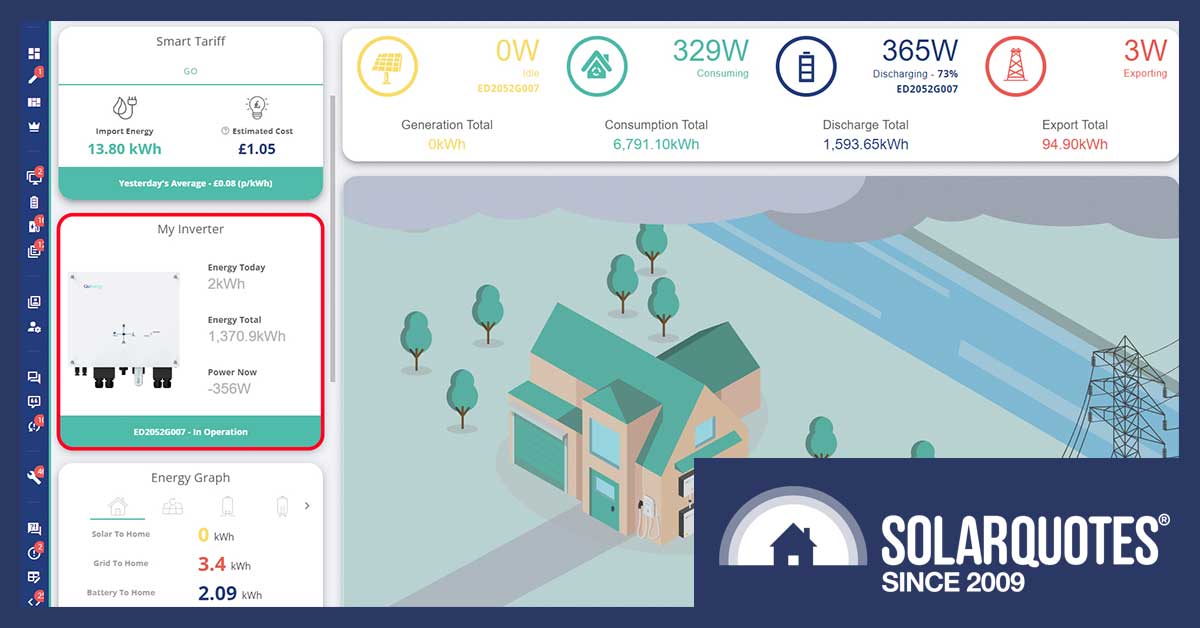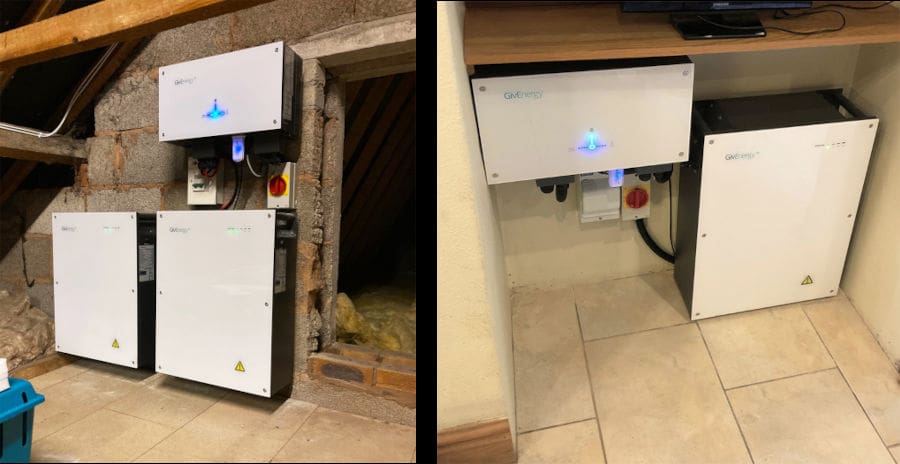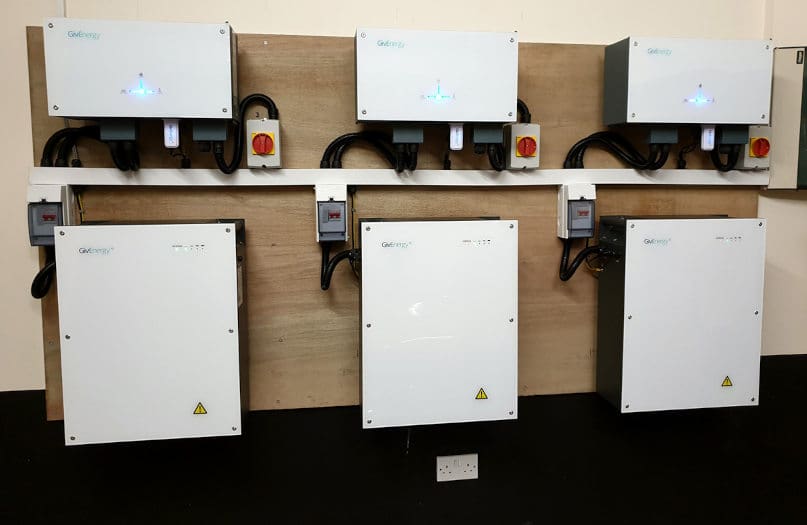
Grey clouds. Even the monitoring has a distinctly British flavour.
Recently, I had the pleasure of walking the halls at the All Energy Solar Conference in Melbourne. For those in the industry, we affectionately call it “Solar Xmess” because it’s the one time of year when we can all get together and passionately debate the finer points over a beer. Some might argue that our drinking industry has a solar problem, but that’s a topic for another day.
Right Now, We’re Talking About Batteries
There must have been at least a hundred different home battery offerings on display. Many established brands showcased their latest technology with impressive displays. An equal number, or perhaps even more, were no-name brands occupying a 3×3 metre sales cube, with a couple of people trying to raise awareness for their generic shiny white boxes. These often included a, yet-to-be-approved in Australia, 5kW hybrid inverter battery combination.
Finn Drew My Attention to Something Different
British company GivEnergy had a sizeable presence at the show with a big sign proclaiming they make the most popular battery in the UK.
I had a good chance to work with their software engineer, and though he couldn’t name the LiFePO4 battery chemistry off the top of his head, he did seem pretty genuine when he claimed to offer a better-than-average integrated product. Their boxes certainly weren’t all of a familiar size and shape, which piqued my curiosity. I had to ask if they were made in England?
Of course, they’re made in China, which is borne out by the little details. With experience, you start to recognize features like the textured powder coat, the threaded feet, and the standard-shaped weatherproof circuit breaker covers that are hallmarks of Chinese manufacturing. Not that it’s a bad thing, Giv tell us they wholly own the factory turning out the gear they design. The fit and finish are fine, excellent even, but they don’t have the sleek glass or smooth metallic sheen of some.
Perhaps It’s Bold Honesty Instead of Slick Marketing
The electrical ratings offered by GivEnergy set them apart from the very generic competition and arguably place them on par with industry leaders, depending on the comparison criteria. After dealing with customers disappointed that they can’t have more than one power and one light circuit on battery backup, I’m pleased to report GivEnergy offers some solid ratings.
While brands like Sungrow, Q.cells, and GoodWe offer a 5kW nominal capacity with a 6kW surge for 10 seconds (i.e., 120% at a pinch), Giv Energy’s 48v single-phase offering specifies a 3.6kW output on the backup port. Yes, it’s lower, but they also specify a battery voltage of 45 – 58 volts and a maximum current of 81 amps. When you multiply 45 by 81, you get 3600, meaning it does just what it says on the tin.
The 3-phase machines, with higher battery voltage, perhaps offer better capacity. The nominal output of 6kW divided by 3 phases equals 2kW. Divide that by 230v, and you get 8.7 amps. This is happily more conservative than the 10.5 amps they actually specify as an AC output.

Australians would have a heart attack if they saw batteries inside a living space or a roof cavity. Things are different back in England.
Let’s See If They Come To Australia
Giv also has a range of AC-coupled battery inverters designed to charge on grid energy, which makes sense coming from the less-than-sunny British Isles. They have a full suite of consumer-grade EV chargers, battery storage, some solar inverters and even a smart plug, right up to container-sized commercial systems. All of the equipment is covered by a fully optioned monitoring portal, and they’re also front and center with open APIs published on the website to integrate the solutions into existing building management systems.
They tell us CEC approval is imminent, but so far, they haven’t appeared on the list. It would be good to see some competition offering a comprehensive management system when they do.



 RSS - Posts
RSS - Posts



I’ve seen a few of these installed on some of the UK Sparky channels I watch. They appear to be a decent unit.
They are just a re-manufactured Chinese clone but the software is unique to GivEnergy. I forget the battery brand it’s based on. The issue may well come down to price as being British, their current pricing is all based around the rather strong £.
Would you go for a Tesla Powerwall 2 13.5 kW or a Givenergy All in one 13.5 kW? Seems like the Givenergy has better tech and longevity. Plus the peak power is greater.
Givenergy batteries look good – but we want to see them a little more established in Australia, with proven local tech support, warranty support and ease of integration with stuff like Amber and other VPPs.
Have a 13.5 all in one I think,at the moment not happy as only single phase in a 3 phase home.
Have a 6.6 kw solar so most of my energy is going back to the grid and not charging my battery.
Waiting for a work around that could take 4 to 8 weeks to come from the uk.
If I knew what I know now I would have waited.
Can you send the SLD (single line diagram) of your install to [email protected] ?
The installer must provide this if you haven’t already got it.
Have a 6.3Kw solar system with Enphase micro inverters for 3 phases house. What is the best battery currently available on the market? Please give me an advice. I am confused to what is best to utilise it.
Thanks in advance
Hi Hien,
I would normally recommend you stick with an ecosystem, so your microinverters would be well integrated with an Enphase battery.
Enphase batteries are 5kW peak power, problem is they’re only 5kWh storage, which really isn’t enough.
They really need to have 10 or 15kWh storage capacity for each 5kW of battery inverter.
Rules vary across the country but some DNSPs won’t allow more than 10kW/phase so you could have a single 5kW/5kWh battery unit with 2.1kW of solar connected directly for blackout protection. Better than nothing but not ideal.
Tesla PW3 set up as an AC coupled battery would offer much more storage, even if you were restricted to 5kW inverter capacity.
I think that would likely work well but add more solar if you can.
Or simply add an entire new 3ph system such as Frinius, Sungrow, GoodWe, Sigen.
Put additional DC coupled solar on with the new system & let your Enphase units contribute what they can via AC coupling.